The Mercedes-Benz A-Class was once a funny little people mover-shaped car that fell over at the sight of a Moose, but now it isn’t. It is a far, far better car than it has ever been before too. We head to Melbourne to check it out.
What is it?
This is almost certainly the question Mercedes asked themselves when they sat down to conceive a replacement for the original A-Class.
With the original A- and B-Class, Mercedes was essentially building the same car in two slightly different sizes, so one had to change. It made sense that the smaller one come over all sporty and conventional, while the slightly larger one would stay the tall, people-mover-esque version. This is vasty simplified, by the way.
The result is now far more differentiation between the A-Class and B-Class, with the A-Class becoming far more like, well, the BMW 1 Series, really…
The A-Class range kicks off with the $46,900 A 180, which packs a 90kW/200Nm 1.6-litre four-cylinder petrol engine hooked up to a 7-speed automatic transmission.
The A 180 comes standard with 17-inch alloy wheels, sports seats, parking sensors front and rear, a reversing camera, Bluetooth connectivity, a multi-function steering wheel with shift paddles, cruise control (with a speed limiter), auto start/stop, automatic headlights with integrated DRLs and rain sensing wipers.
The A 200 is available with a choice of two engines – a 115kW/250Nm 1.6-litre four-cylinder petrol or a 100kW/300Nm 1.8-litre four-cylinder diesel – both costing $54,900 and both matched to the same 7-speed auto trans.
Aside from the more powerful engines, the A 200 adds 18-inch alloy wheels, twin exhausts, electric folding exterior mirrors, automatically dimming rear-view and exterior mirrors, synthetic leather seat trim, a leather steering wheel and different interior trim to the package.
The A 250 Sport rounds out the range and comes in at $64,900.
Packing a 155kW/350Nm 2.0-litre four-cylinder engine, again with the 7-speed auto, the A 250 adds 18-inch AMG alloy wheels, an AMG body kit, lower, AMG-tweaked suspension, Bi-xenon headlights, a panoramic sunroof, a unique interior trim with a carbon fibre-look dash (and lots of red highlights!), a flat-bottomed leather steering wheel, LED DRLs and modified sport settings for the 7g transmission and ESP system.
For a complete list of standard equipment and options, click this link: A-Class specifications
What’s it like?
Despite featuring a remarkably similar shape to the BMW 1 Series, there is a key difference between the two German rivals – the A-Class is front – wheel drive.
This should immediately put the A-Class on the back foot when it comes to ultimate handling dynamics. Yet, strangely it doesn’t. Oh, sure, at the ultimate limit it will no doubt lose out to the BMW, but in everyday driving (and with a fair bit of semi-serious thrashing) the A-Class comes across as a seriously good thing indeed.
The only variant we didn’t get to try on the launch was the A 200 petrol, but going off the rest, it too should be a damn fine little car. Starting out in the A 250 Sport was, in hindsight, a good move, as each successive engine variant impressed us more.
While the A 250 was spectacularly quick and especially tenacious, the overly-hard suspension made it quite unsettled on the broken, narrow Melbourne back roads. The A 200 diesel instantly felt more settled and compliant, and had a massive whack of diesel-y torque that made changing gears almost unnecessary.
The A 180 was undoubtedly the surprise – and very possibly the star – of the day though. The little petrol 1.6 was perky and loved to rev, with a strong chunk of power and torque that seemed to always be where you needed it.
Overall, all variants felt well-planted and confident, with sharp turn-in and wonderfully accurate (although slightly light) steering. Build quality and materials were top-notch throughout and the level of standard spec for the money asked was impressive indeed.
The three engine variants we sampled were all impressive, but as mentioned earlier, the base A 180 was the star.
What’s good about it?
It looks utterly fantastic, handles brilliantly and has a range of strong, impressive engines to choose from. Standard spec is high to begin with and the option packs add even more for not a lot more cash.
What’s not so good?
The A 250’s suspension was unnecessarily hard and fidgety over broken surfaces – although it will be interesting to see how it performs on local road surfaces – and some of the trim options are a bit on the far edge of good taste. But other than that, not a lot.
First impressions?
A deeply impressive entrant in the upper/luxury end of the small segment. With FWD handling that comes as close as possible to the BMW 1 Series RWD dynamics, yet with the packaging advantages FWD brings, the A-Class has a lot to boast about.
Add in the fact that it is priced sharply and features an impressive load of standard equipment, and it becomes a very convincing package indeed.
Specifications
Models/prices
A 180 BlueEFFICIENCY – $46,900
A 200 BlueEFFICIENCY – $54,900
A 200 CDI BlueEFFICIENCY– $54,900
A 250 Sport – $64,900
Powertrain
1.6-litre inline four-cylinder turbo petrol producing 90kW/200Nm; seven-speed automatic transmission; front-wheel drive (A 180), 1.6-litre inline four-cylinder turbo petrol producing 115kW/250Nm; seven-speed automatic transmission; front-wheel drive (A 200), 1.8-litre inline four-cylinder turbo diesel producing 100kW/300Nm; seven-speed automatic transmission; front-wheel drive (A 200 CDI), 2.0-litre inline four-cylinder turbo petrol producing 155kW/350Nm; seven-speed automatic transmission; front-wheel drive (A 250 Sport)
Fuel consumption: 5.8L/100km (A 180), 6.1L/100km (A 200), 4.6L/100km (A 200 CDI), 6.6L/100km (A 250 Sport)
CO2 emissions: 135g/km (A 180), 141g/km (A 200), 121g/km (A 200 CDI), 152g/km ( 250 Sport)
Safety
ANCAP/EuroNCAP rating: 5 star
Air bags: 9
Stability control: yes
Lap/diagonal belts: 5

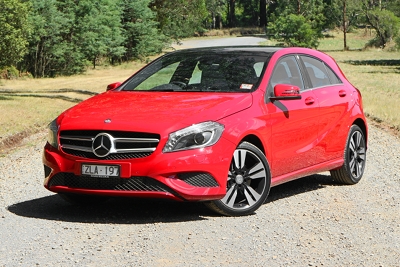
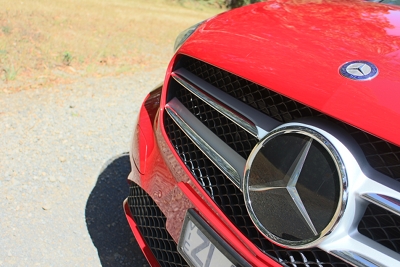
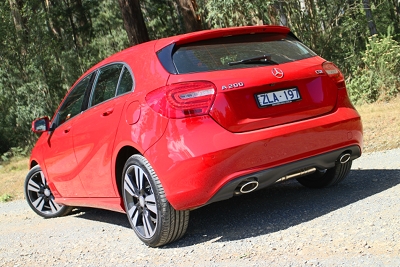
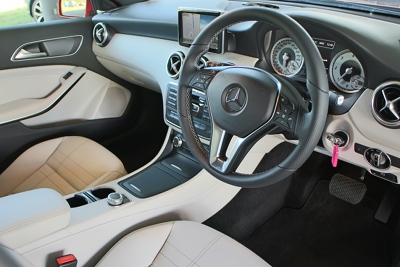
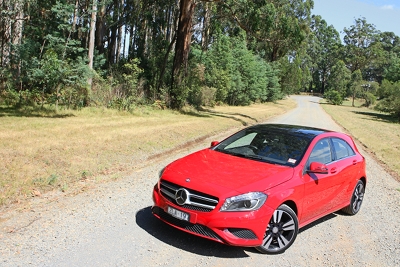

You must be logged in to post a comment.